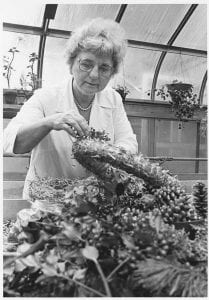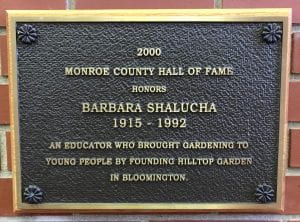By: Arielle Pare, Bicentennial Intern, Class of 2021, International Studies, French, Bloomington
Edited by: Ellie Kaverman and Bre Ann Briskey, Bicentennial Graduate Assistants

Dr. Barbara Shalucha, Associate Professor Emeritus of Biology at Indiana University, brought together community connections and an appreciation for nature to improve the resources available to both Bloomington residents and IU students.
Dr. Shalucha is well known for her work in establishing the Hilltop Garden and the Junior Garden Workshop, as recognized by a commemorative plaque in her honor outside the Hilltop Nature Center.[1] She accumulated many titles throughout her career, including botanist, journalist, Girl Scout leader, and was sometimes referred to as “the Bobby Knight of gardening.”[2]
Education
Shalucha was born on December 9, 1915 in Vermont to Russian-born parents.[3] She earned her bachelor’s degree in 1937 and master’s degree in 1938 at the University of Vermont.[4] After she received her doctorate in horticulture at Ohio State University in 1947,[5] she joined the IU botany and horticulture faculty in 1948 to help develop new plant science courses.[6]
The Formation of Hilltop Gardens
In 1948, Shalucha established Hilltop Gardens in a one-acre alfalfa field north of IU’s main campus.[7] One source stated that she “wrangled” the land from university president Herman B Wells;[8] however, Wells became the first honorary member of Hilltop for his support of the youth garden and their philosophy.[9]

The Hilltop youth gardening program began in 1948, soon after Hilltop’s founding. The first program included 17 young gardeners around the ages 8 to 13.[10] The youth gardening program nearly tripled in participants within two years.[11] It is now one of the oldest programs of its kind in the United States.[12]
The formation of Hilltop was a significant achievement towards uniting the IU and the greater Bloomington communities, as its sponsorship included the Bloomington Parks and Recreation Department, the IU Bloomington Garden Club, and the IU Botany Department.[13]

The Hilltop Garden was as much of a laboratory for students of education, biology, and medicine[14] as it was for the wellbeing of Bloomington children. “Our over-all pattern [for Hilltop Garden] is simple and flexible,” Dr. Shalucha said, “It gives the student garden teacher an opportunity to devote his time to the teaching of horticulture and learning to interpret the significance of a program throughout the country.”[15]
As a professor and the faculty adviser for the IU Botany Club, she dedicated the majority of her time to students enrolled at the university.[16] In 1952 she said, “I am very much interested in our students on this campus… I have group discussions in my home for many students throughout the year.”[17]

Making a Difference: Dr. Shalucha’s Work at McCormick’s Creek
Dr. Shalucha also expanded off-campus opportunities for IU students, allowing them to gain practical experiences throughout the local area. One such location was McCormick’s Creek State Park in Spencer, Indiana, where she facilitated the development and improvement of a trailside nature museum beginning in 1949.[18]
Dr. Shalucha described the museum as “a nature workshop in which students learn how biological phenomena in a given area may be explained to the public,” while also helping to remodel the building.[19] In 1950, Dr. Shalucha was a guest apprentice at the American Museum of History in New York City and at the Buffalo Natural History Museum in Buffalo, New York. These experiences were vital to Shalucha gaining knowledge on museum management and preparation.[20]

The nature museum project at McCormick’s Creek helped both students and park visitors both learn and appreciate the state’s natural history and beauty.[21] Students held the responsibility of presenting information to the public about native species and natural phenomena.
Students worked with specialists in audio-visual education to create exhibits for the museum.[22] The extent of student involvement in the project reflected Dr. Shalucha’s formidable combination of leadership and scientific knowledge.
Public Outreach
Although the subject materials for her undergraduate and graduate classes were rooted in biology topics such as introductory horticulture and environmental biology, Dr. Shalucha sought to teach leadership as well. In a 1953 essay titled “Garden Magic for Thousands More,” she listed some of the skills that students gained through horticulture management:
“[Students] have been introduced to the many different ways of getting along with people, young and old; they have acquired a little deeper understanding of human frailties. But, most important is that these young leaders have been introduced to the ‘magic’ of gardening, its art and science, for youth. It is here where they lead boys and girls to discover that there is dignity in work, a noble quality for today’s living.”[23]
Outside of the garden, Dr. Shalucha was equally active. She served on the Board of Directors at the Indiana University Y.W.C.A. from 1958-1964 and was also the president of the Women’s Faculty Club from 1966-1967.[24] In addition to these roles, she established and directed IU’s nature museum and student laboratory in the 1960s. Dr. Shalucha managed IU’s educational greenhouses, including those currently located by Jordan Hall.[25] These greenhouses served as an experimental laboratory for IU students to learn about horticulture management and design for future use in gardens.[26]
As further proof of Dr. Shalucha’s dedication to both IU and Bloomington, she was chair of the City Beautification Committee on the Parks and Recreation Department in 1958.[27] On numerous occasions, she organized or addressed national conferences on horticulture and botany.[28]

Dr. Shalucha remained a prolific writer for the rest of her life. Throughout her career, she wrote at least 46 news releases, 5 books, 12 scientific publications, and 17 non-scientific publications–some of which appeared in The New York Times and Better Homes and Gardens.[29] One essay written in 1951, ‘Children Grow in Gardens’,[30] was founded on Dr. Shalucha’s basic philosophy, where she emphasized the ability of gardens to improve the world.
“Thousands upon thousands of boys and girls need gardening to better prepare themselves as citizens of tomorrow,” she wrote. “Where are the children’s gardens? Wherever they are, there you will find boys and girls busy in a program with a purpose providing for the building of strong bodies, healthy minds, thus happy people.”[31]
Dr. Shalucha became internationally recognized for her work combining youth development and gardening. She was appointed a member of the advisory board for the Young Garden Council in Washington D.C in 1963,[32] and was selected as a delegate by the China-United States Scientific Exchange in 1985 to lecture on botanical gardens in China.[33] As a frequent speaker for schools, radio and television programs, and various national and international conferences, Dr. Shalucha earned her place as a trusted public figure.[34]

Her belief in the power of gardens is perhaps best summarized in her own words:
“How rich are the harvests for the junior gardener? From his garden plot… he supplied food for home use. He has learned to prepare soil for planting; how to fertilize the garden; how to make and interpret a garden plan; how to cultivate and why; how to thin and why; how to spray and for what bug and disease; how to CARE FOR HIS TOOLS.” She wrote in ‘Children Grow in Gardens.’ “Most important is that he has done it with other boys and girls, sharing the fun and fellowship in working together.”[35]
Dr. Shalucha retired from Indiana University in 1986[36] and died in 1992.[37]
Bibliography
Aronson, Earl. “The Weeders Guide.” The Brazosport Facts (Freeport, Texas), October 16, 1962, p. 3.
Awards, 1972-1976, Barbara Shalucha papers, Collection C76, Indiana University Archives, Bloomington.
“Barbara Shalucha, Former Professor at IU, Was Pioneer in Youth Gardening.” The Indianapolis Star, May 13, 1992, p. 17.
Biographic Note, Barbara Shalucha papers, Collection C76, Indiana University Archives, Bloomington.
“IU Students to Shoulder Hoes, Rakes.” The Times (Munster, Indiana), March 28, 1950, p. 9.
“Local Briefs.” The Burlington Free Press (Burlington, Vermont), October 3, 1947, p. 16.
Myers Sharp, Jo Ellen. “Hilltop Reaches Half-Century Pinnacle.” The Indianapolis Star, July 12, 1998, p. 182.
Munsen, Rosemary. “Civic Garden Symposium Blossoming.” The Cincinnati Enquirer, August 7, 1981, p. 21.
Resume 1954, Barbara Shalucha papers, Collection C76, Indiana University Archives, Bloomington.
Shalucha, Barbara, Articles on Hilltop 1941-1966, Barbara Shalucha papers, Collection C76, Indiana University Archives, Bloomington.
Shalucha, Barbara. “NEW PLANTS FROM OLD; Valuable Aids for Growing Slips Are Now Available, Thanks to Science.” The New York Times, February 24, 1946.
Unthank, Kitty. “Outdoor Classroom Cultivating Hoosier’s Gardening Knowledge.” The Indianapolis Star, June 13, 1985, p. 27.
Zaltsberg, Bob. “Monroe County Hall of Fame Members.” Herald Times Online, November 26, 2018. https://www.hoosiertimes.com/herald_times_online/news/local/monroe-county-hall-of-fame-members/article_333dca59-9dc2-5e3b-ad7a-e0d06ca6bc0e.html.
Notes
[1] Archive Biography, Barbara Shalucha papers, Collection C76, Indiana University Archives, Bloomington.
[2] Jo Ellen Myers Sharp, “Hilltop Reaches Half-Century Pinnacle.” The Indianapolis Star, July 12, 1998, p. 182.
[3] Birth Certificate, Barbara Shalucha papers, Collection C76, Indiana University Archives, Bloomington.
[4] Archive Biography, Barbara Shalucha papers, Collection C76, Indiana University Archives, Bloomington.
[5] Ibid.
[6] Resume 1954, Barbara Shalucha papers, Collection C76, Indiana University Archives, Bloomington.
[7] Earl Aronson, “The Weeders Guide,” The Brazosport Facts (Freeport, Texas), October 16, 1962, p. 3.
[8] Jo Ellen Myers Sharp, “Hilltop Reaches Half-Century Pinnacle,” The Indianapolis Star, July 12, 1998, p. 182.
[9] Resume 1954, Barbara Shalucha papers, Collection C76, Indiana University Archives, Bloomington.
[10] Articles on Hilltop, Barbara Shalucha papers, Collection C76, Indiana University Archives, Bloomington.
[11] Earl Aronson, “The Weeders Guide.” The Brazosport Facts (Freeport, Texas), October 16, 1962, p. 3.
“IU Students to Shoulder Hoes, Rakes.” The Times (Munster, Indiana), March 28, 1950, p. 9.
[12] Hilltop Gardens and Nature Center: A history of community gardening and education efforts at Indiana University. Blogging Hoosier History, Indiana University Bloomington, August 2, 2011, . https://blogs.libraries.indiana.edu/iubarchives/tag/barbara-shalucha/.
[13] Articles on Hilltop, Barbara Shalucha papers, Collection C76, Indiana University Archives, Bloomington.
[14] Earl Aronson, “The Weeders Guide.” The Brazosport Facts (Freeport, Texas), October 16, 1962, p. 3.
[15] Articles on Hilltop, Barbara Shalucha papers, Collection C76, Indiana University Archives, Bloomington.
[16] Annual Reports 1948-1967, Barbara Shalucha papers, Collection C76, Indiana University Archives, Bloomington.
[17] Ibid.
[18] Resume 1954, Barbara Shalucha papers, Collection C76, Indiana University Archives, Bloomington.
[19] Articles on Hilltop, Barbara Shalucha papers, Collection C76, Indiana University Archives, Bloomington.
[20] Annual Reports 1948-1967, Barbara Shalucha papers, Collection C76, Indiana University Archives, Bloomington.
[21] “DNR History.” Indiana Department of Natural Resources, n.d. https://www.in.gov/dnr/3245.htm.
[22] Articles on Hilltop, Barbara Shalucha papers, Collection C76, Indiana University Archives, Bloomington.
[23] Articles on Hilltop, Barbara Shalucha papers, Collection C76, Indiana University Archives, Bloomington.
[24] Resume 1954, Barbara Shalucha papers, Collection C76, Indiana University Archives, Bloomington.
[25] Ibid.
[26] Annual Reports 1948-1967, Barbara Shalucha papers, Collection C76, Indiana University Archives, Bloomington.
[27] Ibid.
[28] Resume 1954, Barbara Shalucha papers, Collection C76, Indiana University Archives, Bloomington.
[29] Barbara Shalucha, “New Plants from Old; Valuable Aids for Growing Slips Are Now Available, Thanks to Science.” The New York Times, February 24, 2006. https://www.nytimes.com/1946/02/24/archives/new-plants-from-old-valuable-aids-for-growing-slips-are-now.html.
Resume 1954, Barbara Shalucha papers, Collection C76, Indiana University Archives, Bloomington.
[30] Resume 1954, Barbara Shalucha papers, Collection C76, Indiana University Archives, Bloomington.
[31]” Children Grow in Gardens,” Barbara Shalucha papers, Collection C76, Indiana University Archives, Bloomington.
[32] “Barbara Shalucha, Former Professor at IU, Was Pioneer in Youth Gardening.” The Indianapolis Star, May 13, 1992, p. 17.
[33] Ibid.
[34] Resume 1954, Barbara Shalucha papers, Collection C76, Indiana University Archives, Bloomington.
[35] Articles on Hilltop, Barbara Shalucha papers, Collection C76, Indiana University Archives, Bloomington.
[36] Indiana University Board of Trustees Minutes, February 1, 1986.
[37] “Barbara Shalucha, Former Professor at IU, Was Pioneer in Youth Gardening.” The Indianapolis Star, May 13, 1992, p. 17.